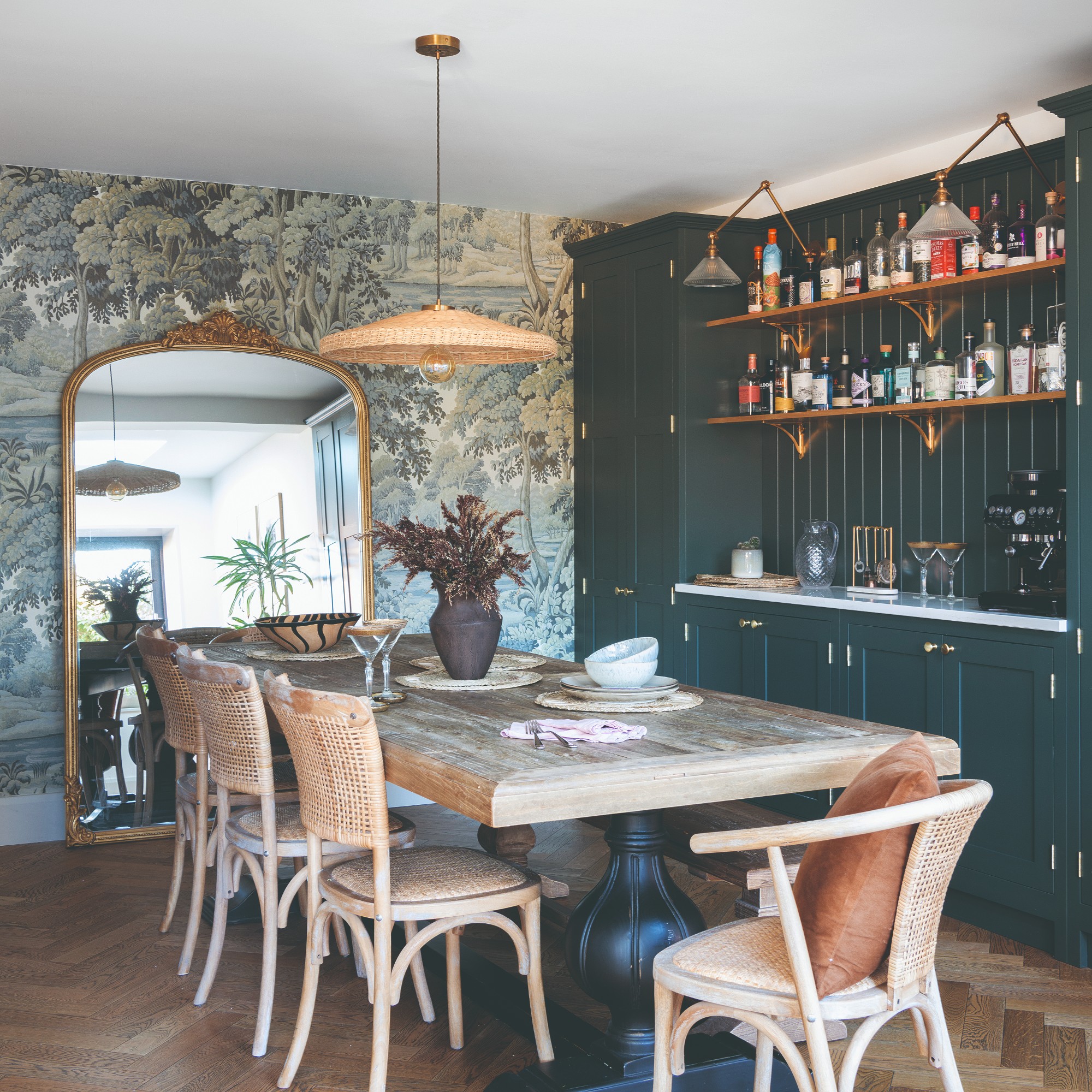
Our days are often organised around our meals – that’s how important of a role they play in our day-to-day life. So creating a pleasant atmosphere in the place that we eat, our dining rooms or dining areas, can also set the right tone for the rest of our day. And incorporating well thought-out dining room lighting ideas can considerably help with that.
Lighting is a crucial element of creating an ambiance in any room and therefore should never be neglected when decorating a space. But as the dining room is the place where you gather with your family on a daily basis and where you entertain guests, creating the perfect atmosphere should be at the centre of your dining room ideas, whether that’s through lighting or dining room colour schemes.
Dining room lighting ideas
‘Lighting is a key design element in dining rooms, due to the role it plays in creating ambience and an inviting atmosphere for meals and entertaining,’ says Mara Rypacek Miller, founder of Industville.
Marlena Kaminska, designer at ValueLights, agrees, ‘The lighting in your dining room should be versatile, just like the space. Whether it’s hosting a dinner party, a romantic dinner date, or working from the dining table, each scenario requires a different type of light.’
And these lighting ideas will help you achieve the right atmosphere for every occasion.
1. Layer your lighting

One of the biggest lighting trends of the moment is layering multiple sources of light – combining table lamps, wall lights, floor lamps, spot lights and feature pendant lights.
‘Layering your lighting is key,’ says Julian Page, head of design at BHS. ‘Combine ambient lighting with accent and task lighting. Start with a central pendant or chandelier for general illumination, then add wall sconces or table lamps to highlight architectural features or artwork. This layered approach ensures your dining room is well-lit for both casual meals and special occasions.’
Matthew Currington, technical director at The Lighting Superstore, continues, ‘An overhead pendant light or chandelier works beautifully to draw attention to the dining area. Pair this with wall sconces for a soft glow that adds warmth. This layered approach creates the right ambiance for dining – whether you’re hosting a formal dinner or enjoying a family meal. Plus, as the evening develops, you may want to consider ditching the central overhead light and simply using the surrounding wall lights for added romance and ambience. To achieve the best lighting, aim for at least three to four light sources.’
2. Place a few tea lights or candles on the table

If you’re looking for some budget dining room ideas on how to light up the space and make it feel cosy and even romantic, then going for a few candles and/or tea lights scattered or carefully placed on the table (depending on the aesthetic you’re going for) is the perfect way to go about it.
‘Remember to bring glow in with tea lights dotted about on your table, to help create an inviting atmosphere,’ says Ally Dowsing-Reynolds, founder and lighting expert at Dowsing & Reynolds.
3. Add a dimmer to the main light
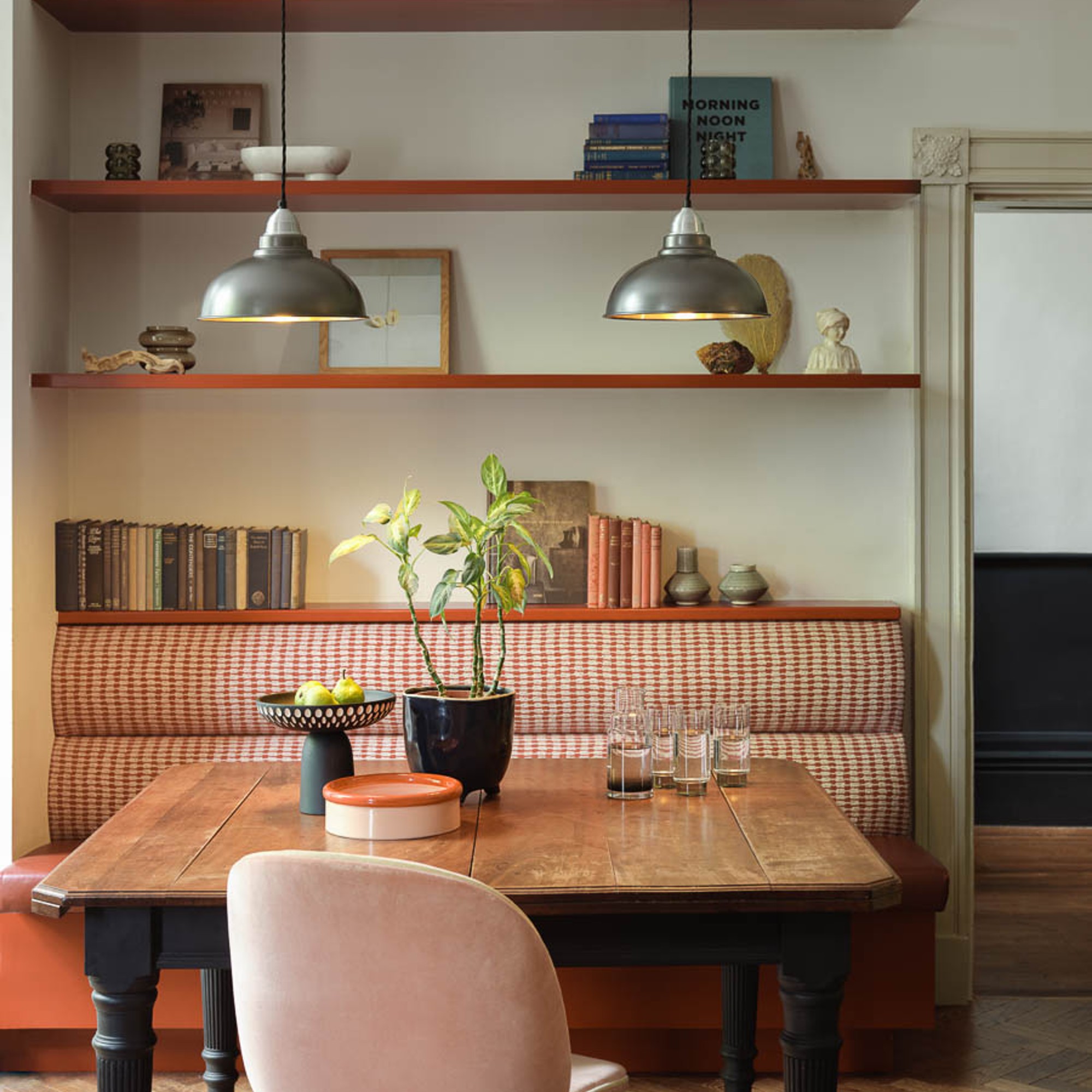
One of the most convenient ways that easily enables you to control your lighting and the feel of it is through installing a dimmer which is something that pretty much every one of the experts we’ve spoken to has recommended for the dining room.
‘Where possible, opt for lighting with a compatible dimmer or smart lighting. Both provide the ability to adjust the light level of a room at a moment’s notice and delicately control the ambient mood, depending on the situation,’ Mara at Industville says.
Marlena at ValueLights adds, ‘Dimmable bulbs are a great option to provide the versatility needed for this space, allowing the lighting to really set the mood whatever the scenario.’
4. Go for pendants made with natural materials
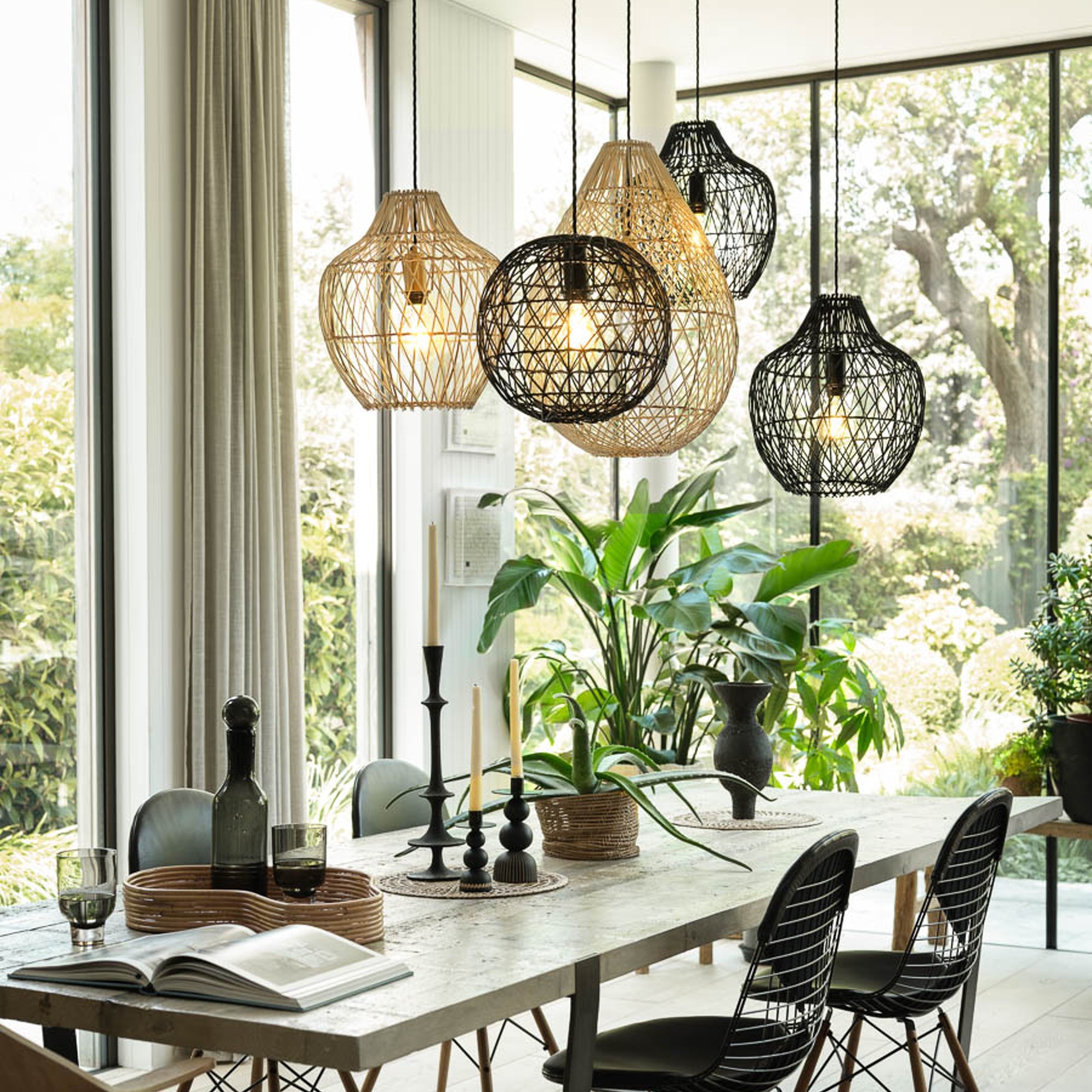
Opting for natural materials over synthetics in interiors is one of the biggest home decor trends at the moment and one of the symptoms of biophilic design which displays our desire to be closer to nature. And pendant lights made from natural materials such as rattan are rising in popularity.
‘Opting for pendants made from natural materials will foster a laid-back, convivial environment, perfect for social gatherings and family meals,’ Mara at Industville says.
As the name suggests, this Industville design is inspired by coastal, beachy vibes. And the loosely woven rattan style leaves the light to be the literal star of the show.
Why not pair the natural rattan look with the ever-so-popular scalloped trim? Scallops are still everywhere, making our homes and interiors look pretty as a picture and we love this subtle take on the trend.
We love irregular, organic-inspired shapes. And this pendant light from Next is the perfect example of that with its double layer of rattan woven into subtle waves which will add a sense of movement into your dining room.
5. Choose a proportionately sized light

While rules can of course be broken, it’s good to know what the rules are to begin with as they often make for a well-balanced look. For example, while oversized pendant lights can be a statement look, it is recommended to opt for one that’s not too big or not too small, but rather just right. And there is a hack you can use to determine what the perfect size for your dining room is.
‘Proportions are key, and it is best to follow this rule: a light should be about half the width of your table but two-thirds the length of the table. This will ensure adequate lighting reaches all areas of the table, removing the ends of the table being cast in darkness,’ Matthew at The Lighting Superstore says.
6. Use statement lighting as your starting point
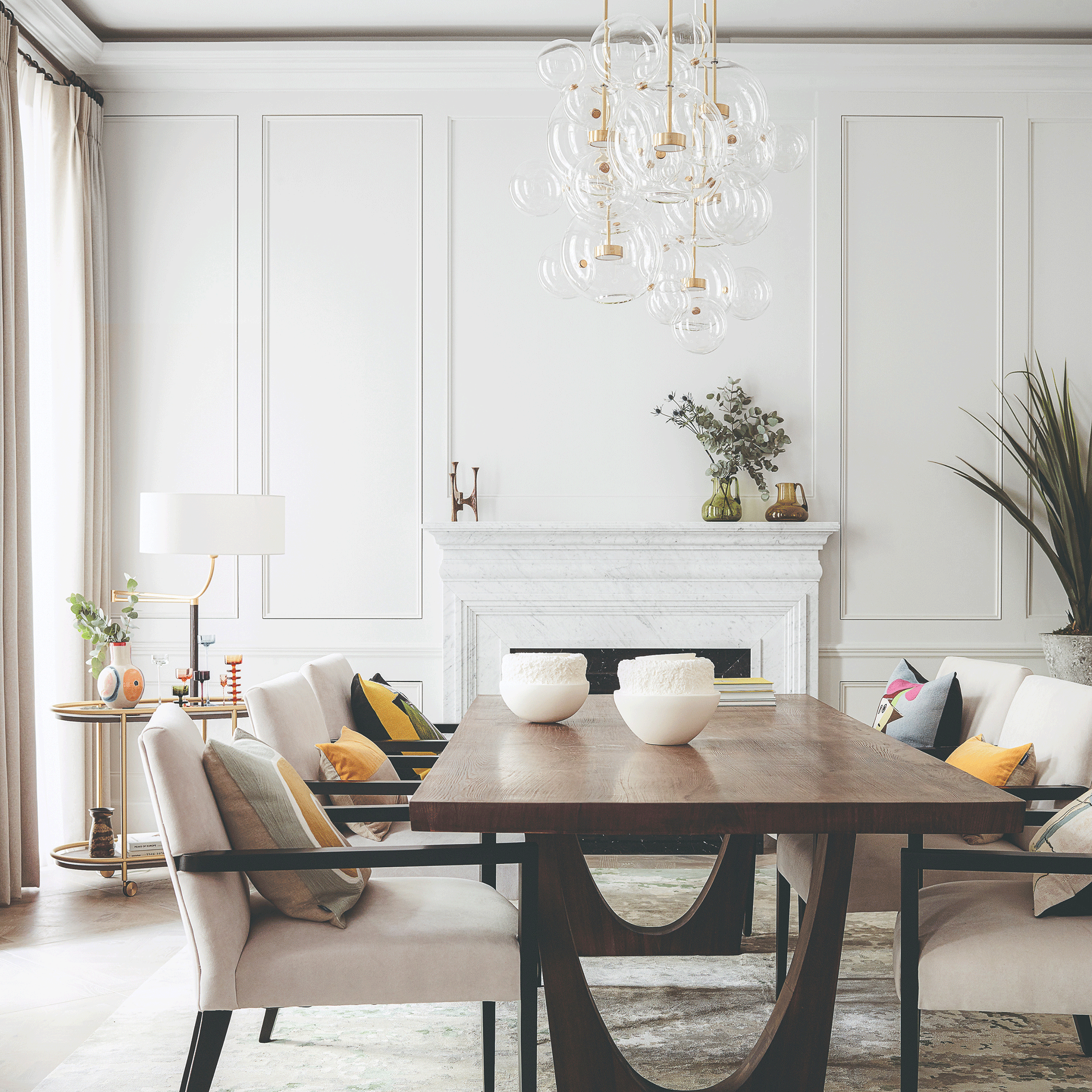
You may find a light that you just have to have, which could be the starting point for your dining room scheme. This beauty is a case in point. Made from the lightest glass balls in different sizes with barely-there gold fittings. It appears to float like bubbles. A light like this needs neutral walls for it to shine. The design is so delicate, that any bold colour scheme would detract from it, so build your dining room colour scheme around it.
'Our best-selling Ribbon pendant light diffuses a dimmable warm glow, while acting as an artistic design piece with its looping curves, offering a touch of luxury when poised above a dining table and a sleek alternative to a chandelier,' says Claire Ansty, lighting buyer at Heal’s. Similarly, the Makiko Pendant Collection by Heal’s offers a range of showstopping fixtures that cast a dramatic yet beautifully ambient glow – perfect when hung individually or as a cluster above the table.
7. Keep it simple with an oversized pendant
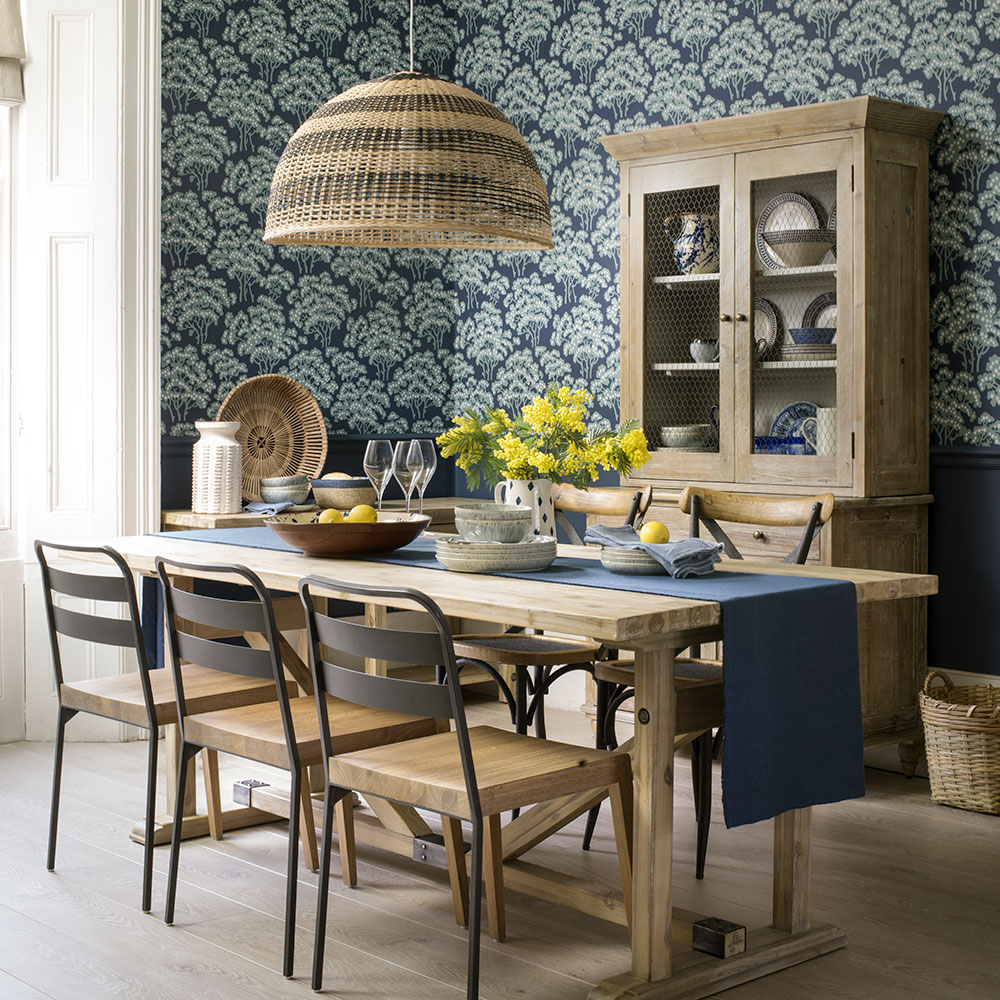
For an uncluttered look, a classic white pendant shade is hard to beat and an easy dining room lighting idea. 'Hanging pendants work really well when positioned over a dining room table, and to draw attention to the centre of the room, choose something big and impactful,' Mara at Industville advises.
'If you use your dining room to host parties often, you might want to consider changing your shades for the occasion. Treat the dining room lighting ideas the same way you would your wardrobe - keep it looking and feeling fresh for every party.'
8. Add shine with metallics

Metallics add instant glamour and are the perfect pairing to glamorous dining room wall decor ideas. Having double pendants over the dining table puts light where you need it. Not only do metallics add shine to the space, but these ones are also hammered so they have a textured finish and they bring a modern touch to a traditional space.
‘A dimmable pendant – or, for a dramatic look, a row of pendants - is useful for switching from functional to relaxation mode,’ says Charlie Bowles, director of Original BTC. ‘Consider also accent lighting to highlight areas of interest – it’s a great way to showcase a collection of china, or wall art.'
9. Create a vintage style with a chandelier
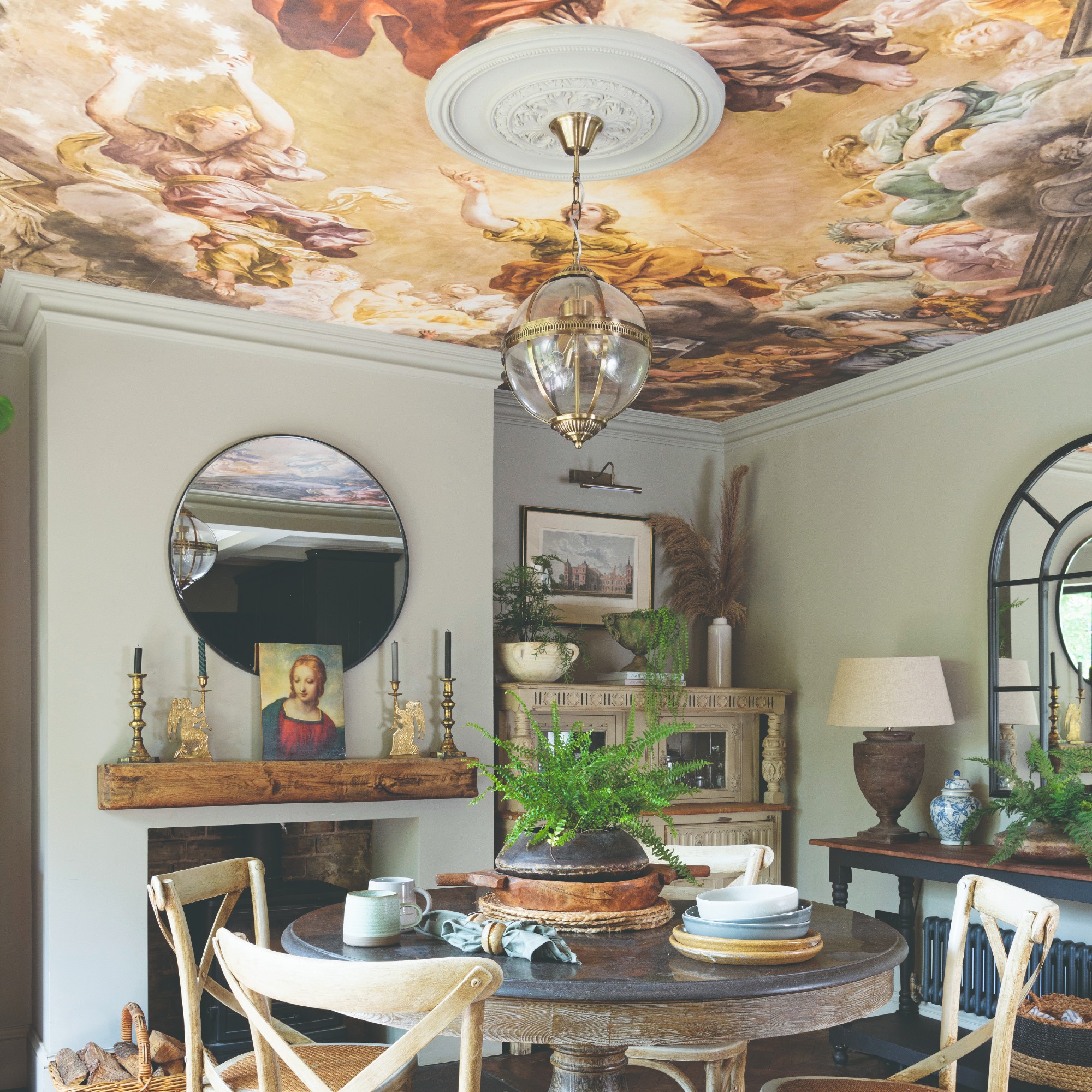
Chandeliers may vary in style from traditional ones to uber-modern ones and are a timeless dining room lighting idea. They have been with us for centuries and will continue to do so – they are so versatile and can create a great talking point over a table.
If you are looking for a vintage look, a metal, French-style one with candle holders is a good choice that won’t date. They come in sizes from large to small, so choose one that suits the size of your room.
10. Zone the space

If you are working with small dining room ideas or your dining area is set into an alcove, use a statement light to zone the space and draw the eye in. Visually, make sure it’s centred over the table and choose a strong colour such as this black design, then add colour with cushions in a plain room to add a bit of life.
A colourful or patterned blind would also be a good background to the light, to bring in more colour and make the space feel cosier.
11. Go for an industrial vibe
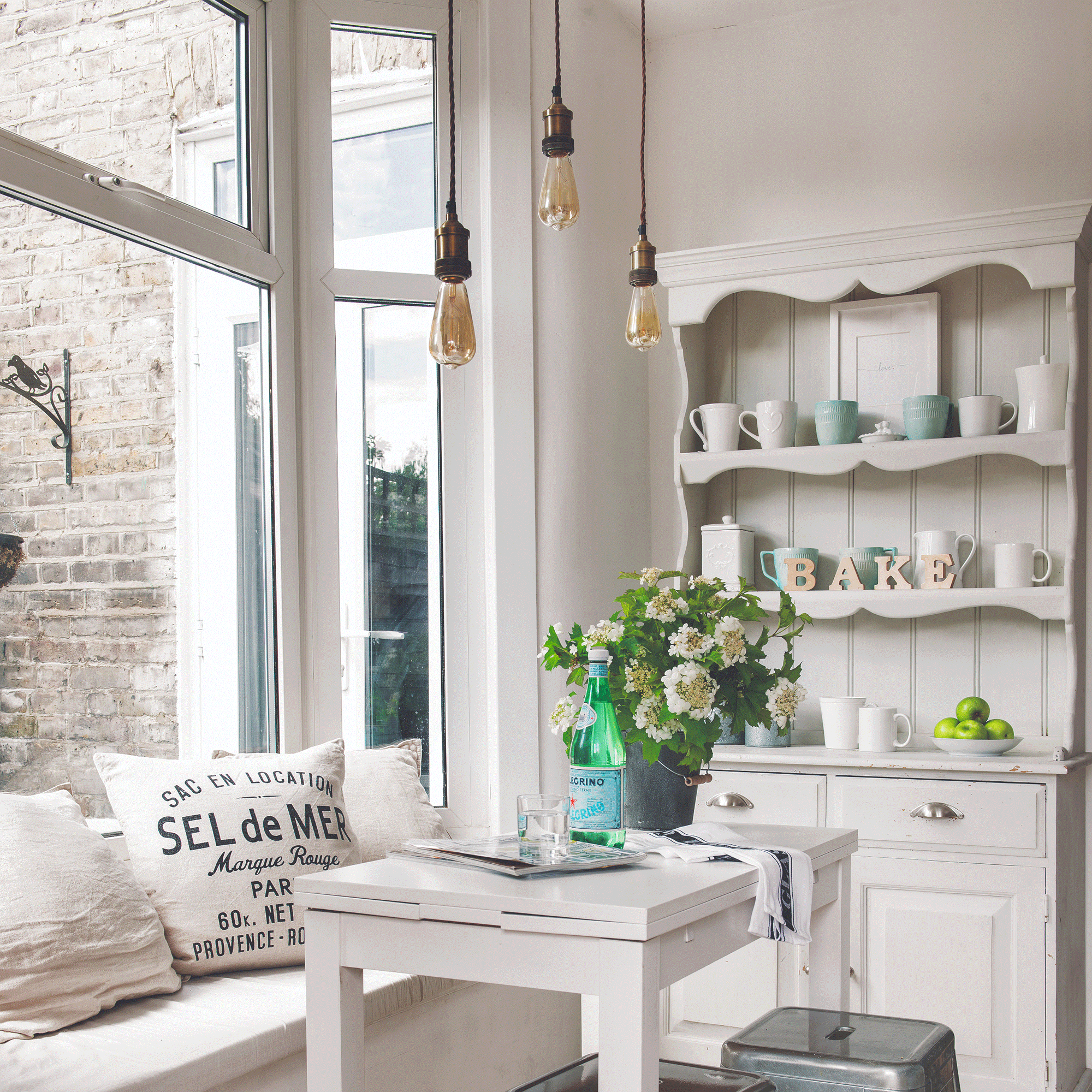
There have been a lot of industrial-style lights around in recent years and they are a lovely dining room lighting idea. Use them singly over a small table or hang a few at different heights as they have here.
They tend to have filament bulbs which are designed to be seen and traditional cord that you can have in different colours to suit your decor. They don’t give off a lot of light but are a nice design feature.
12. Introduce colour with your lighting choice
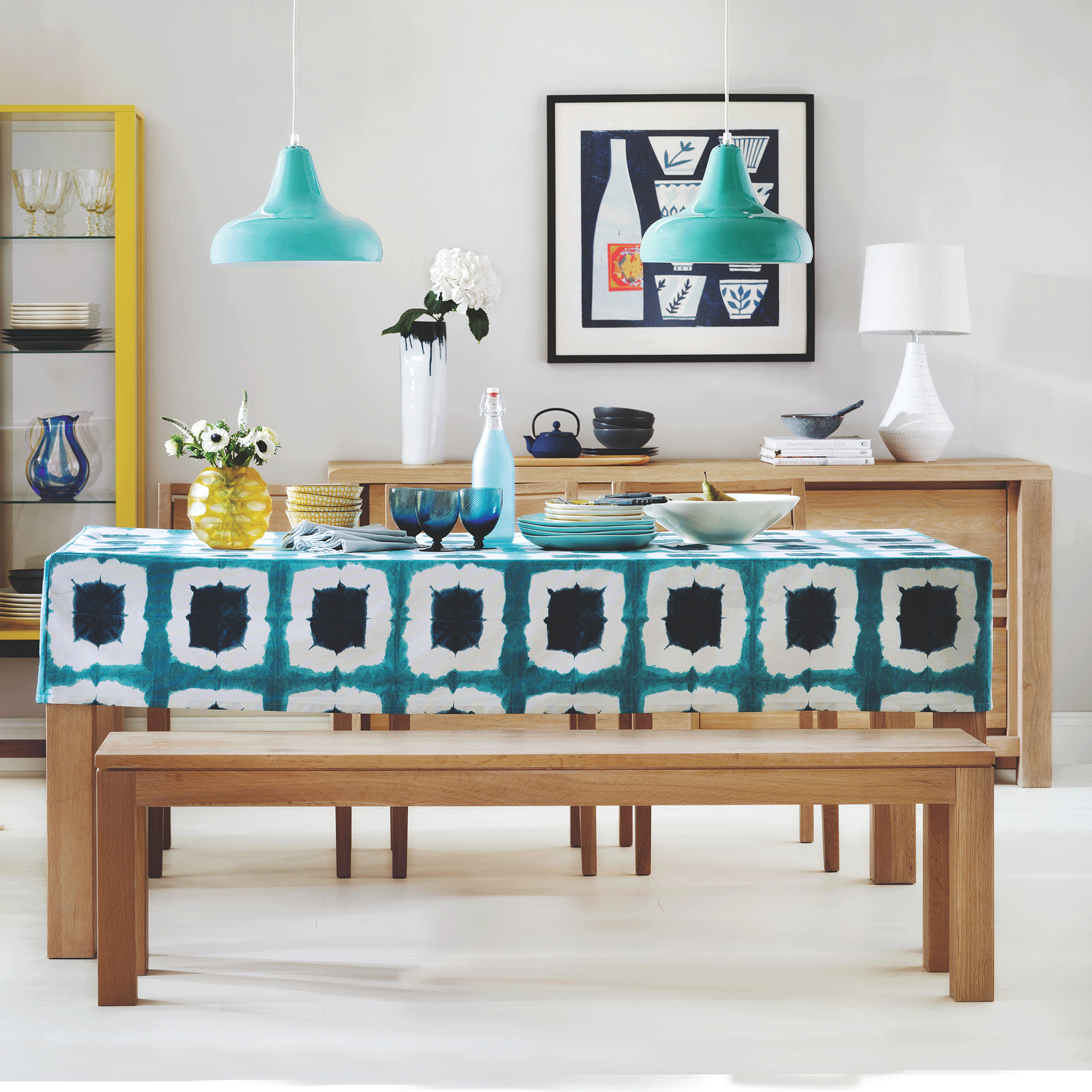
If you feel like a colour refresh in your dining room, it’s a simple dining room lighting idea to add coloured pendant lights, and you don’t need an electrician to do it. There are some reasonably priced ones around, these ones are glass, so easy to clean too. Then build up your colour story with a bold tablecloth, china and glassware, or artwork for an instant colour hit to change up the room.
13. Put the lighting where you need it
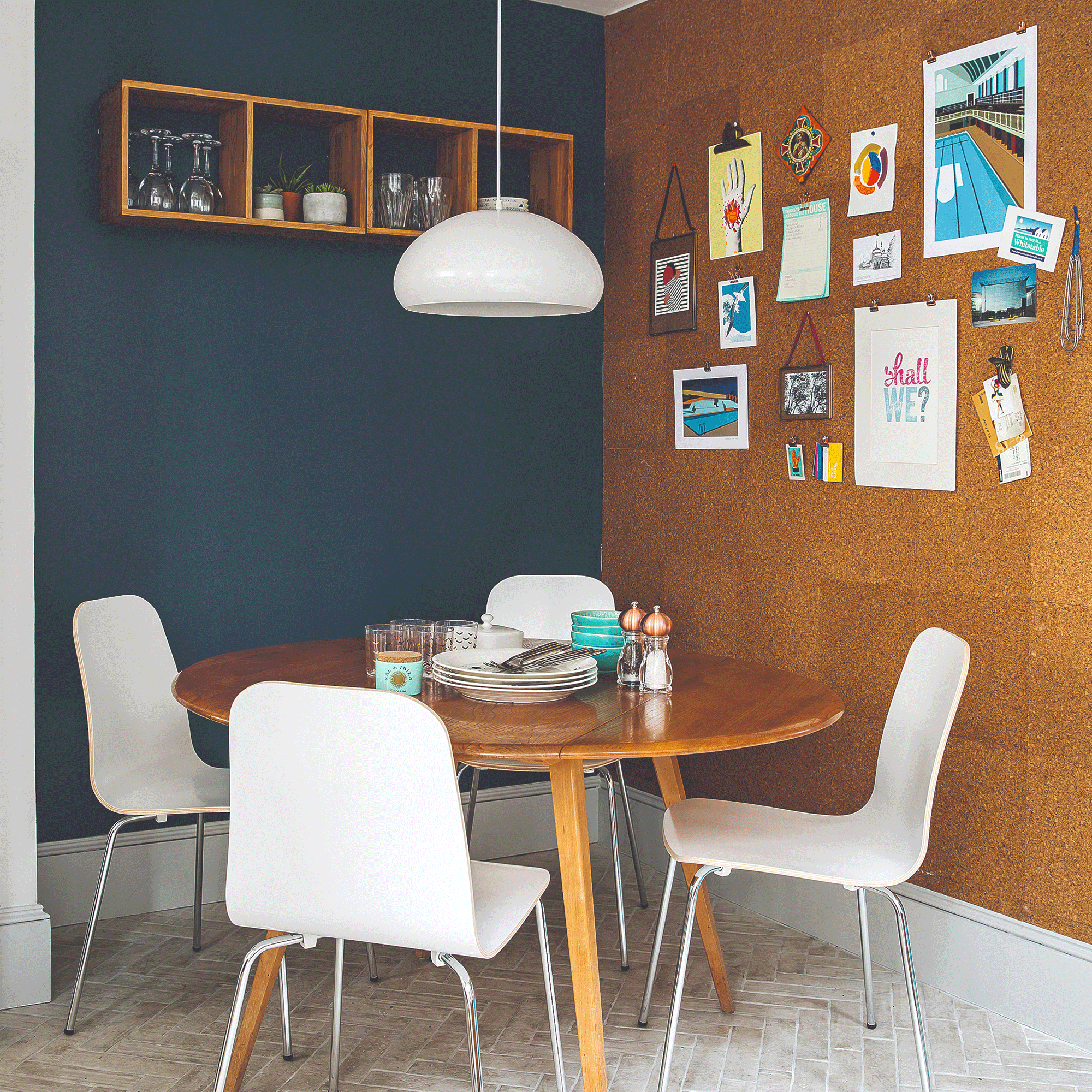
Pendant lights aren’t always where you want them to be, but with the trend for industrial lighting with trailing wires as a design feature, you can simply add a hook into the ceiling to get the light where you need it, or to centralise it over a table.
There is some symmetry in this dining room too, the round pendant light is placed above a round table for a pleasing look.
14. Go for drama with an unusual light
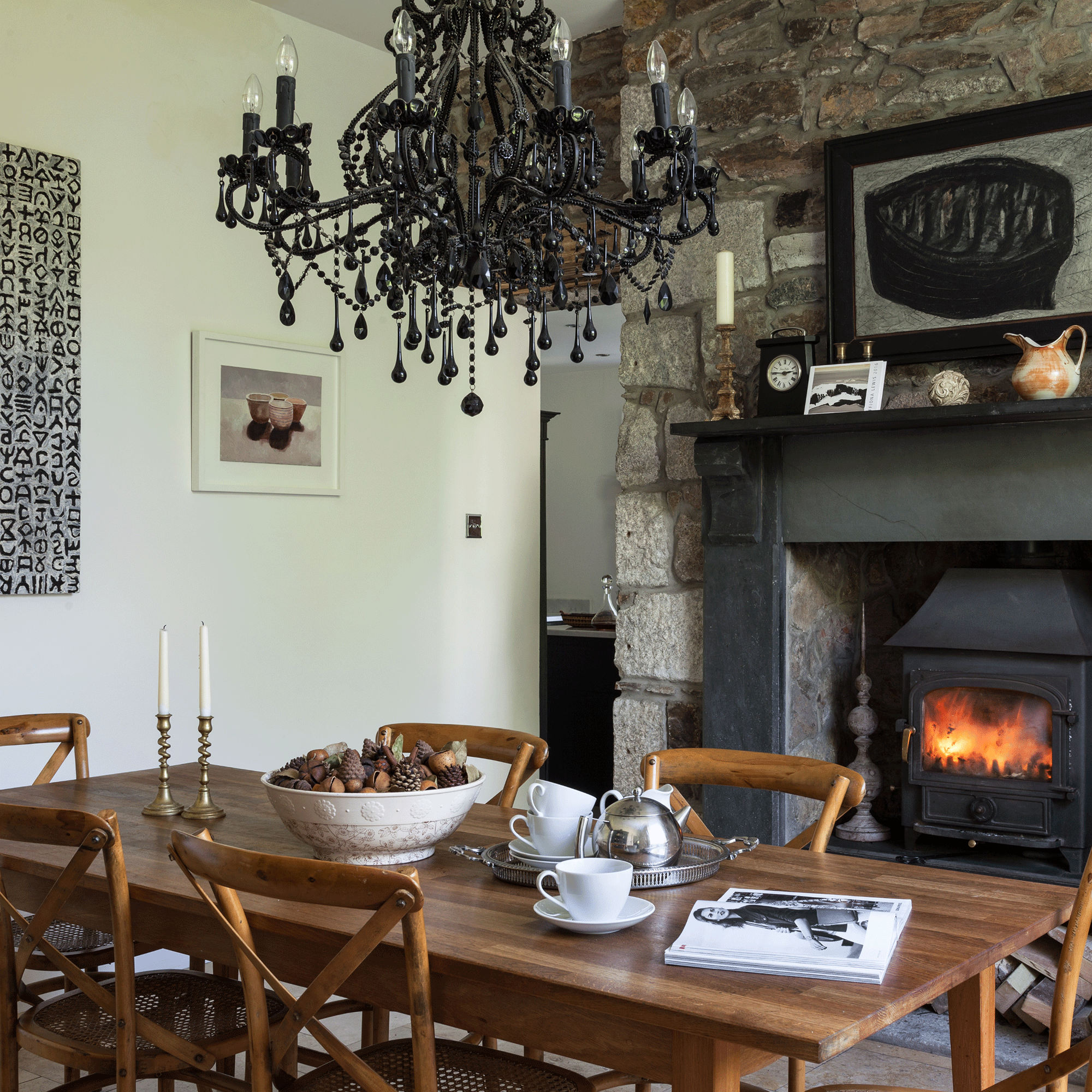
The best dining room lighting idea is to work with the room. This cottage has a striking stone wall and a black fireplace, so a simple light would go unnoticed. Go for something dramatic such as this black glass droplet chandelier with candle holders, it’s gothic, impressive and suits the room perfectly.
15. Choose a pendant bar
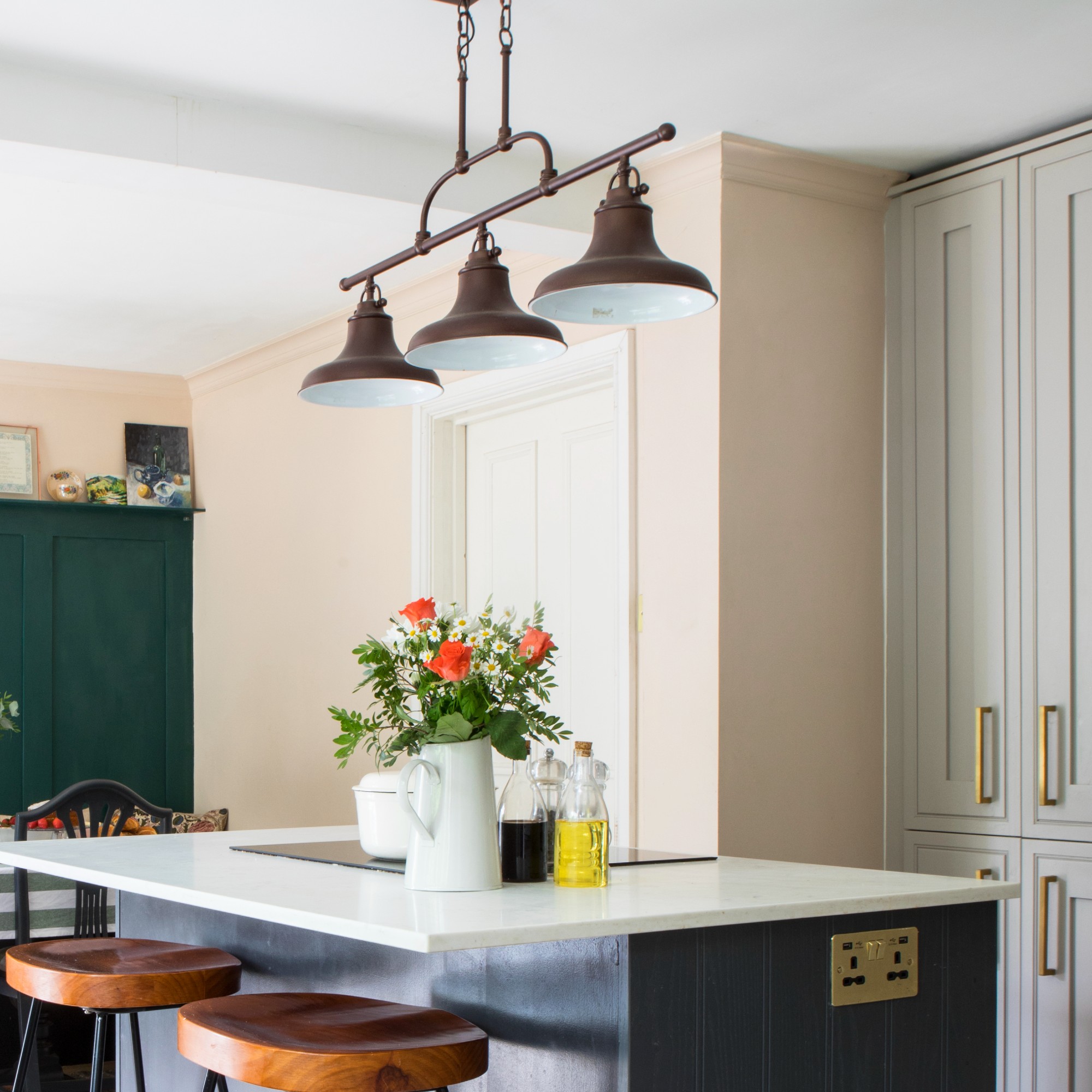
Bar or linear pendants are a great way of lighting a long, rectangular table, or could be used over a breakfast bar. They are made up of multiple lights attached or suspended from a bar structure that is attached to the ceiling, so they are easier to put up than individual lights and it generally means you won’t have to upgrade the electrics.
There are lots of really cool designs in all sorts of shapes and sizes to choose from but bear in mind the light should be between 300mm-600mm shorter than your table for the most pleasing look.
16. Work with your space
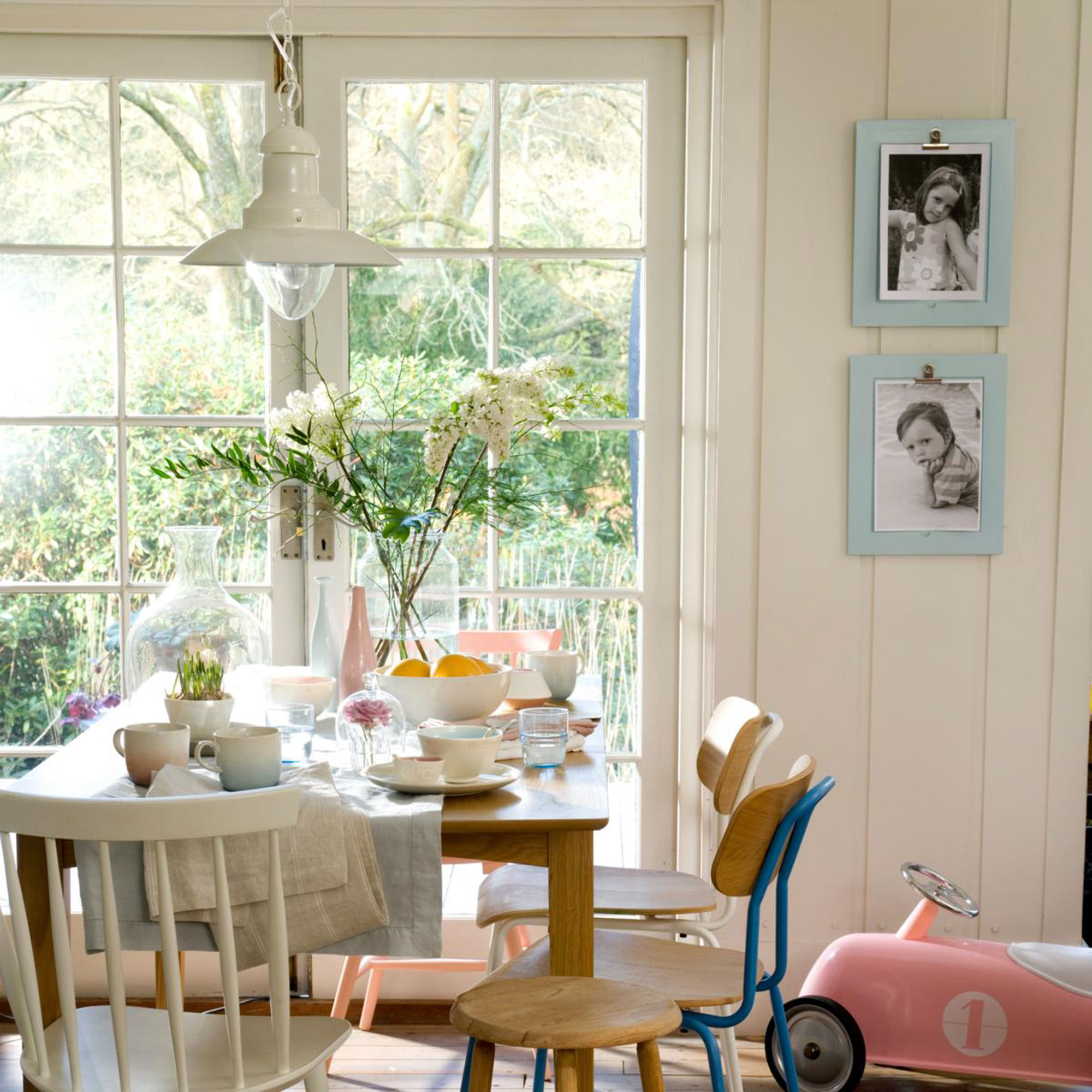
'Dining room lighting needs to be practical and visually appealing,' says Ian Cameron, creative director of Cameron Design House.
'If you're working with small dining room ideas, opt for subtle yet statement pendant lights, the delicacy of this design will add elegance to the area and accentuate the feel of the room. Where room size is at a premium, a large statement chandelier is a great way to optimise the ceiling space, creating interest to the dining space.'
17. Create bold contrast
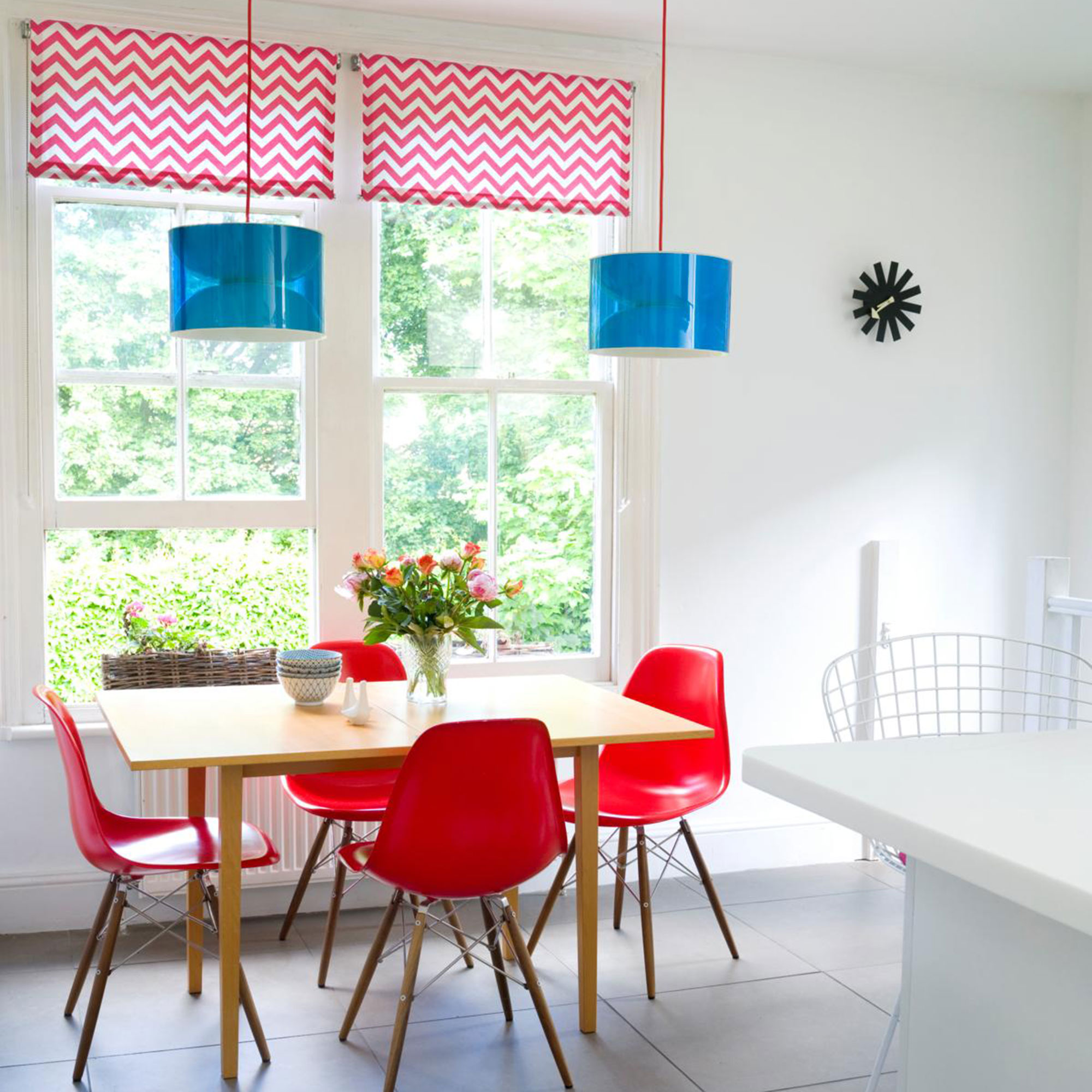
If your dining room space is situated within an open-plan kitchen, then you can use your lighting to help zone the space.
'Whether you have an open plan kitchen diner, or a separate living room, hanging a ceiling light above a dining table creates a focal point and helps to define the space,' explains,' Julian at BHS says.
Reinforce this definition of the space by choosing a boldly contrasting colour for your dining room lighting ideas. This will make the dining area visually zoned even when the lights are off.
18. Play with heights

'Make the dining table the focal point of the room by hanging an impressive fixture above it,' suggests Marketa from Industville Ltd. 'A popular trend for dining room lighting to hang a clustered pendant above the table to create a modern statement show-piece.'
'For best results hang the pendants at varying heights and choose shades of varying sizes and styles to create a standout dining room decor fixture.'
19. Disguise lighting during the day
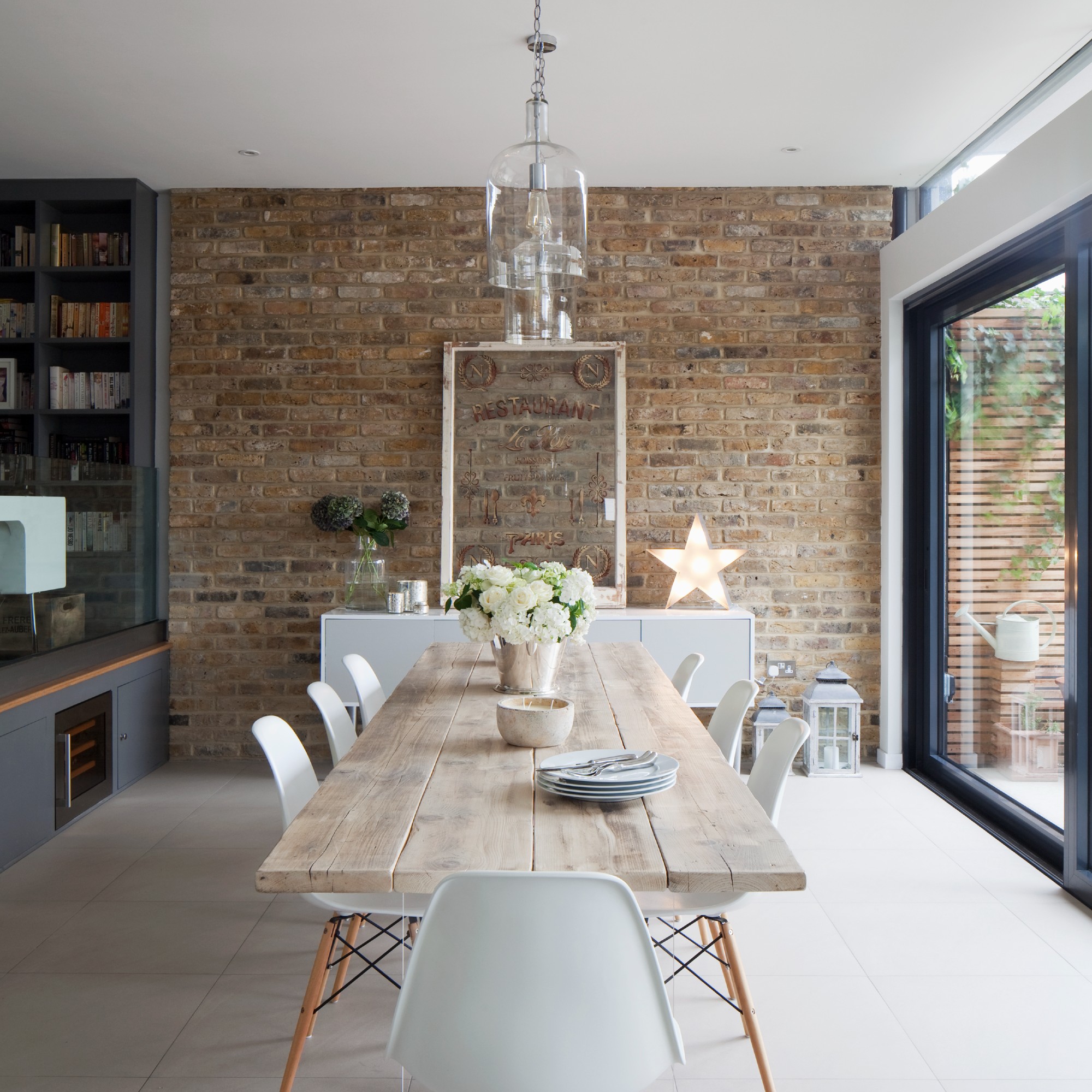
Not all dining room lighting ideas needs to shout about their presence. By choosing the right shade you can effectively hide your light during the day.
Translucent or transparent shades do this especially well. The light will still perfectly light your dining room table decorating ideas at night, but not distract when switched off.
20. Lean into luxe

If you're going for glam, you might as well go all in. Keep things on the contemporary side by switching up the colour or material of your light in contrast to other key pieces around the room. Think gold instead of silver, or metallic instead of glass.
21. Embrace natural light
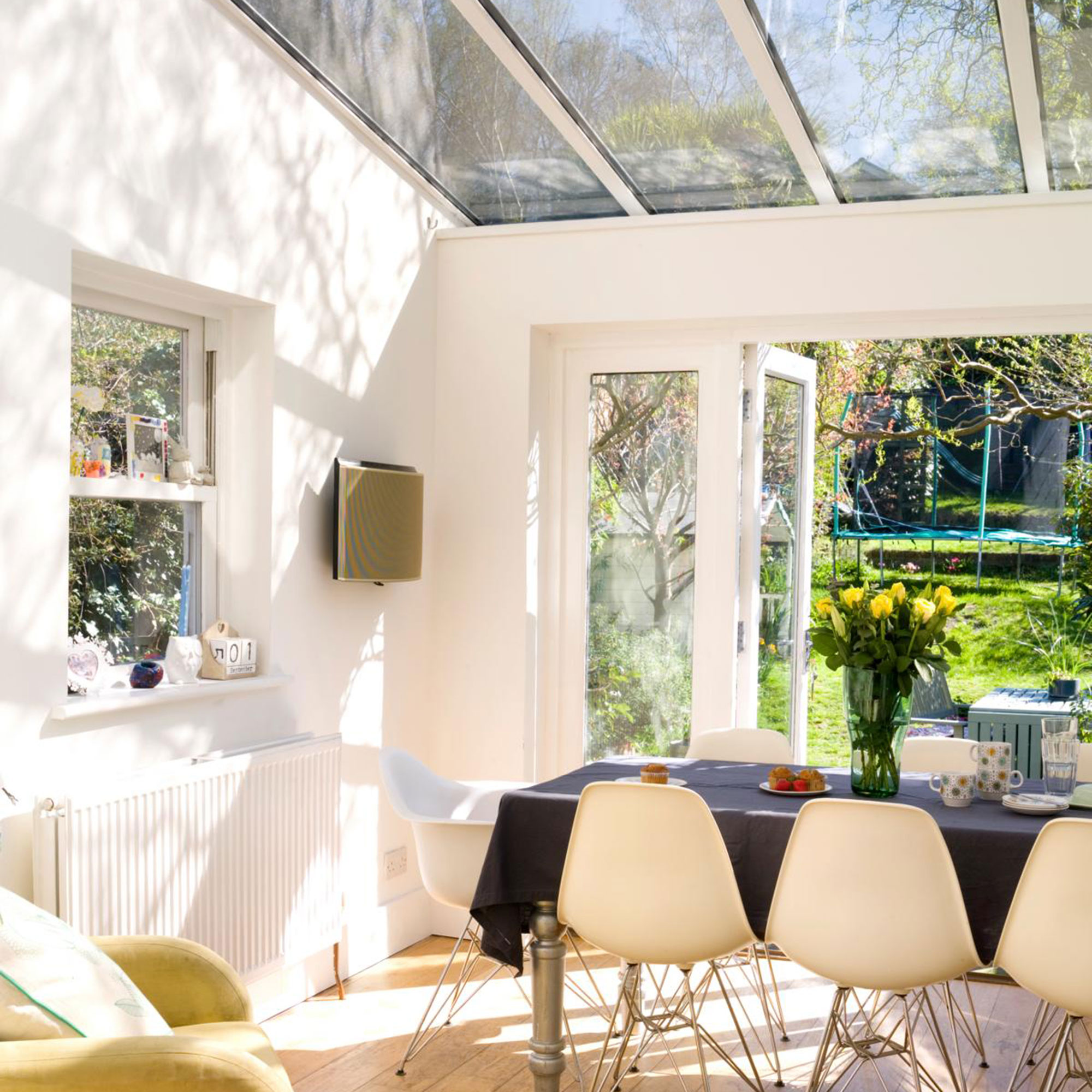
At the end of the day, nothing quite lights as well as natural light. A glass extension is the perfect place to situate your dining table, and you'll be more likely to make use of the space during the day.
At night, collections of candles and lanterns will reflect prettily on the glass walls and ceiling, creating a dreamy ambience.
22. Keep it simple with spotlights
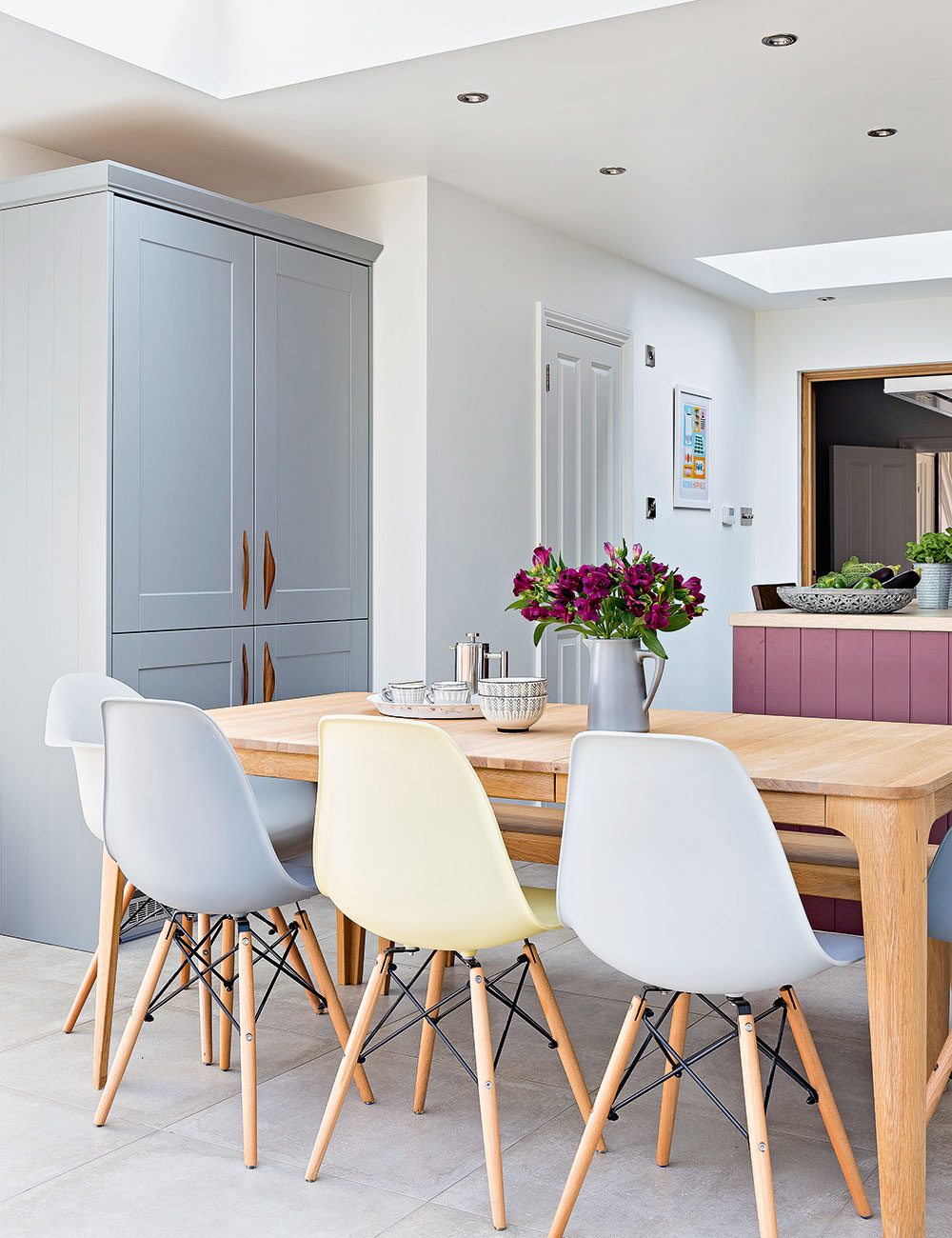
Spotlights are a great choice for dining room lighting ideas - both by themselves and in combination with other light sources.
'Decorative pendants have always been the staple over dining tables but note that some decorative products are not very bright and can cast shadows,' notes Piero De Marchis, director of Detail Lighting. 'It’s advisable to ‘fill-in’ with focused spots either at 4 corners of the table or in line down the centre of the table.'
'Ideally opt for dimmable lighting as these have second function as calming night-time lighting, if you have existing circuits that cannot be changed then there is a new generation of intelligent Bluetooth receivers that allow you to dim the lights where you couldn’t have it before.'
23. Change the mood with rise-and-fall lighting

No space for table lamps? You can switch the atmosphere using a rise-and-fall light. As the name suggests, it can be lowered and raised on a whim. Keep it low to the table for intimacy and high up for a brighter feel.
Installing a smart design will give you the flexibility you need to adapt the space to suit multiple purposes in an instant.
24. Play with scale in the same style
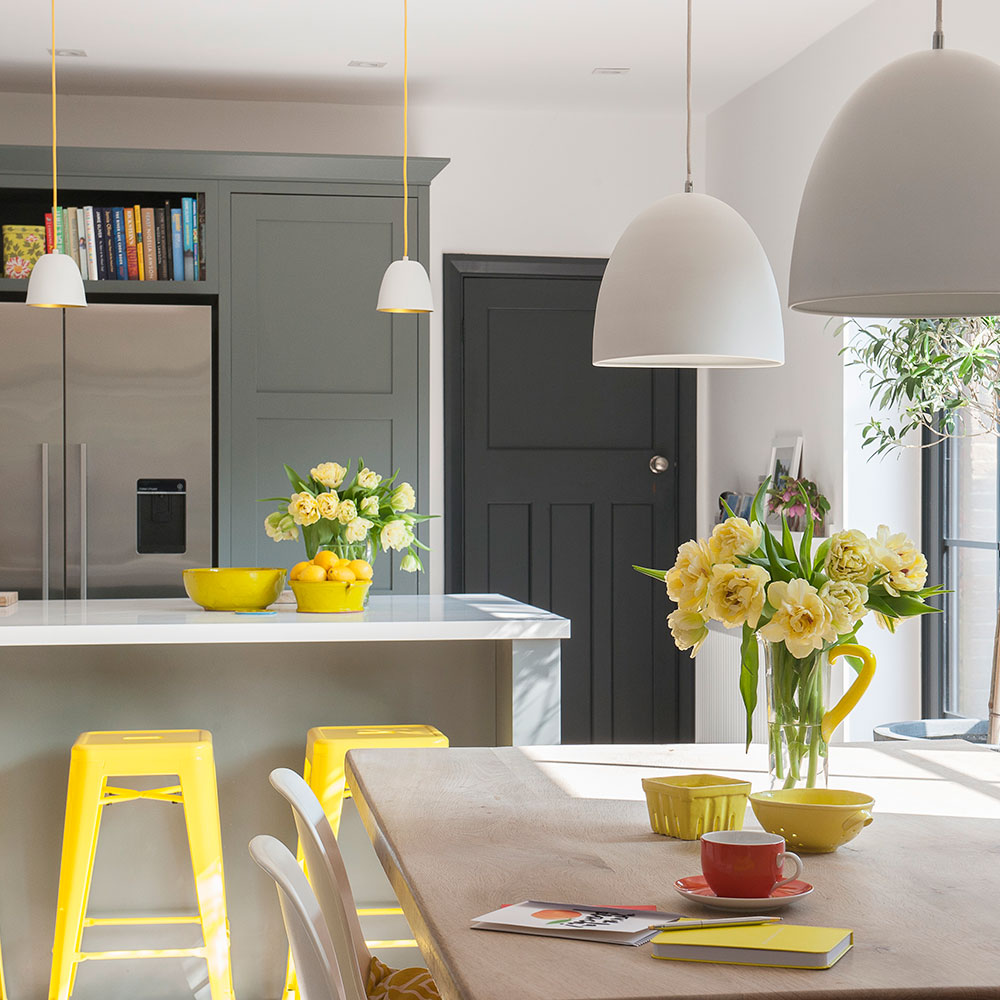
In open-plan spaces, a matchy-matchy approach can ensure a coherent look. But don't go for shades all the same size. Use an assortment of the same style in different sizes to add scale to different zones.
A smart kitchen idea is to source similarly shaped pendants, using the bigger ones over the dining table, and the smaller as task lighting over the island.
25. Add accent lighting with lamps

In a living room, you wouldn't think twice about adding a couple of table or floor lamps. Turn the 'big light' off and you can use them to create a more relaxing mood when you're watching a movie or curling up with your Kindle. So why not do the same in your dining room?
'Create layers of light that you can control separately (ideally on dimmable circuits) to create different moods,' suggests Victoria Rothschild, co-founder of Rothschild & Bickers. 'Even if that is as simple as having a few table and floor lights, as well as a central pendant light, you can balance these together in different ways. Using smaller amounts of light from multiple sources and locations in a space will create visual depth.'
26. Position a floor lamp for directional light

If you don't have a sideboard to place a lamp on why not choose a floor lamp instead?
A floor standing lamp in the corner of the room can also add ambient dining room lighting ideas, allowing the overhead lights to be dimmed or turned off altogether for a more intimate occasion. Welcome candlelight to the table to enhance the atmosphere.
27. Add a pop of coordinating colour
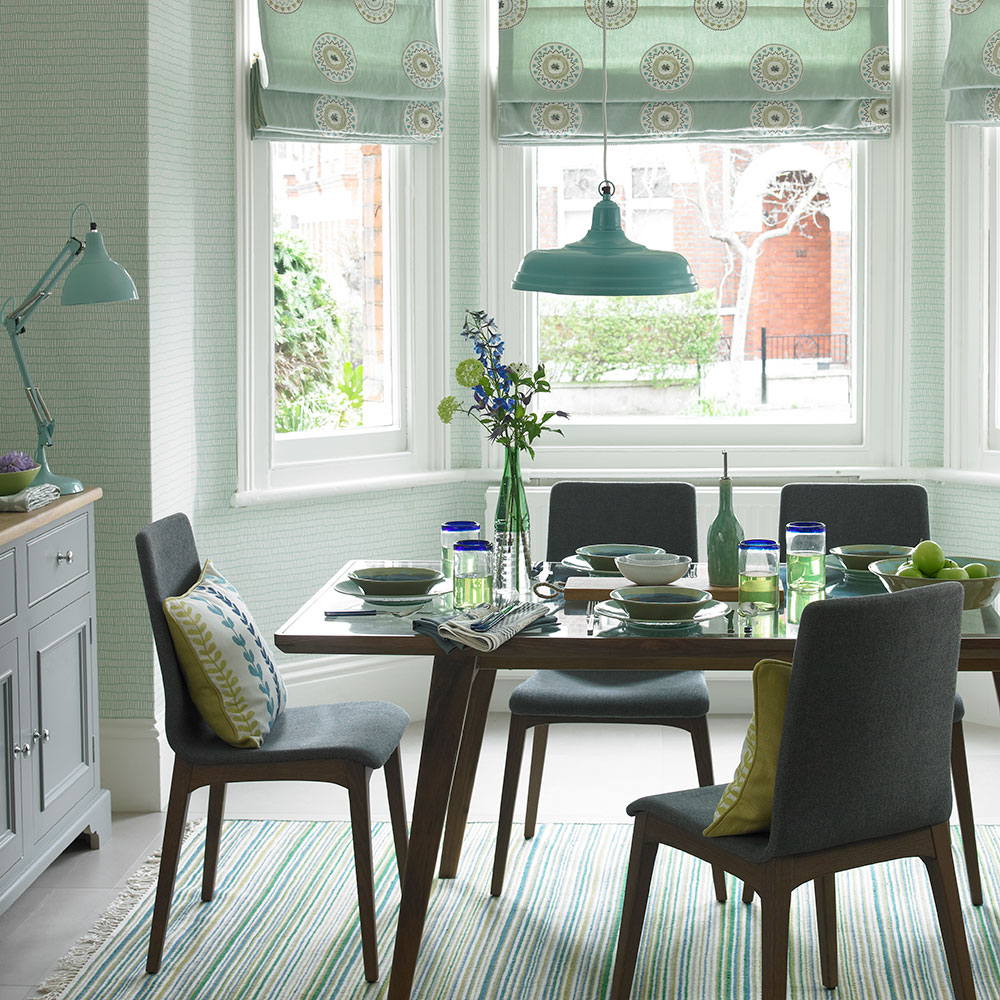
You can really establish an existing colour scheme by hanging a pendant in a coordinating colour. Enamel designs come in all the shades of the rainbow, so you're sure to find one that's exactly right.
Up the ante with an Anglepoise-style lamp on a nearby sideboard. Though they're typically used on a desk, they'll work well in a dining room, since you can angle the bulb differently depending on the mood you're trying to create.
28. Mirror a kitchen lighting scheme
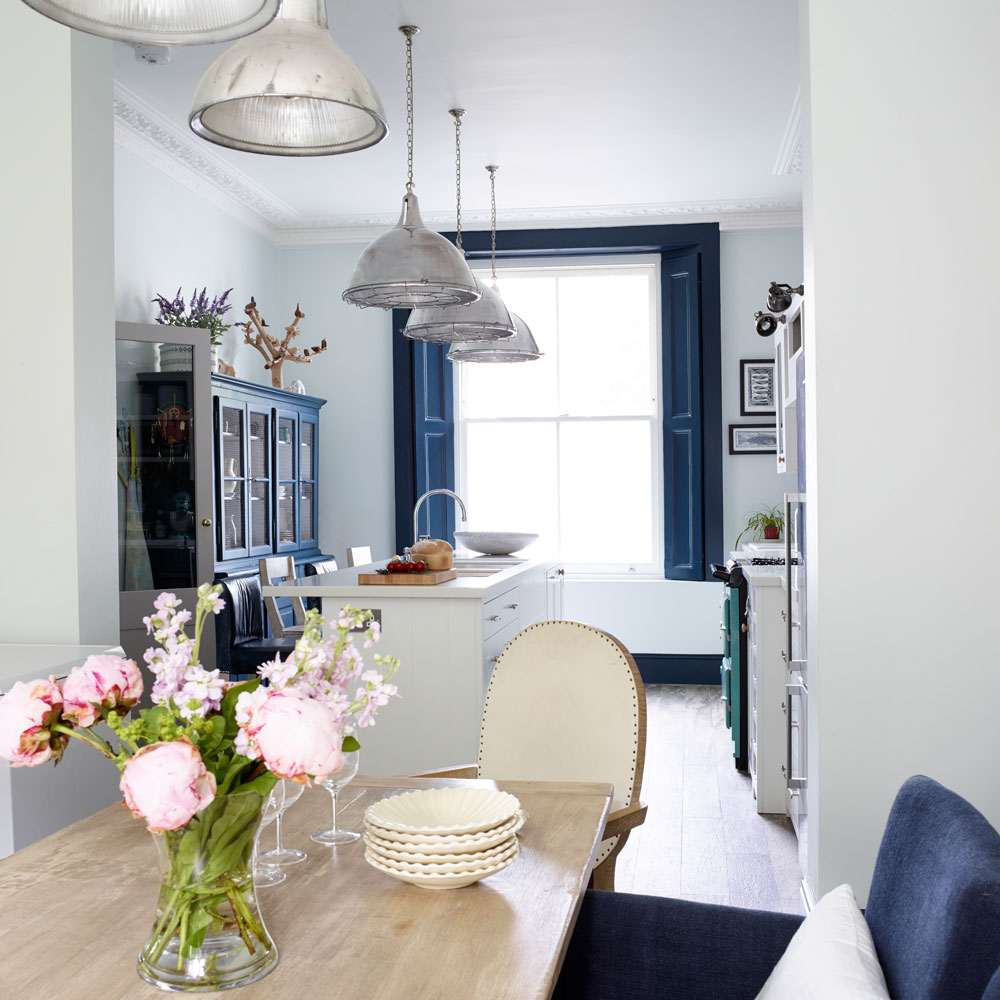
If your dining room is off the kitchen, create a more cohesive, open-plan vibe with matching decor – and that includes the lighting.
Mirror kitchen lighting ideas to welcome a seamless flow from one room to the other, transitioning the journey through from prep to serving and dining.
29. Stagger heights and sizes to make a statement
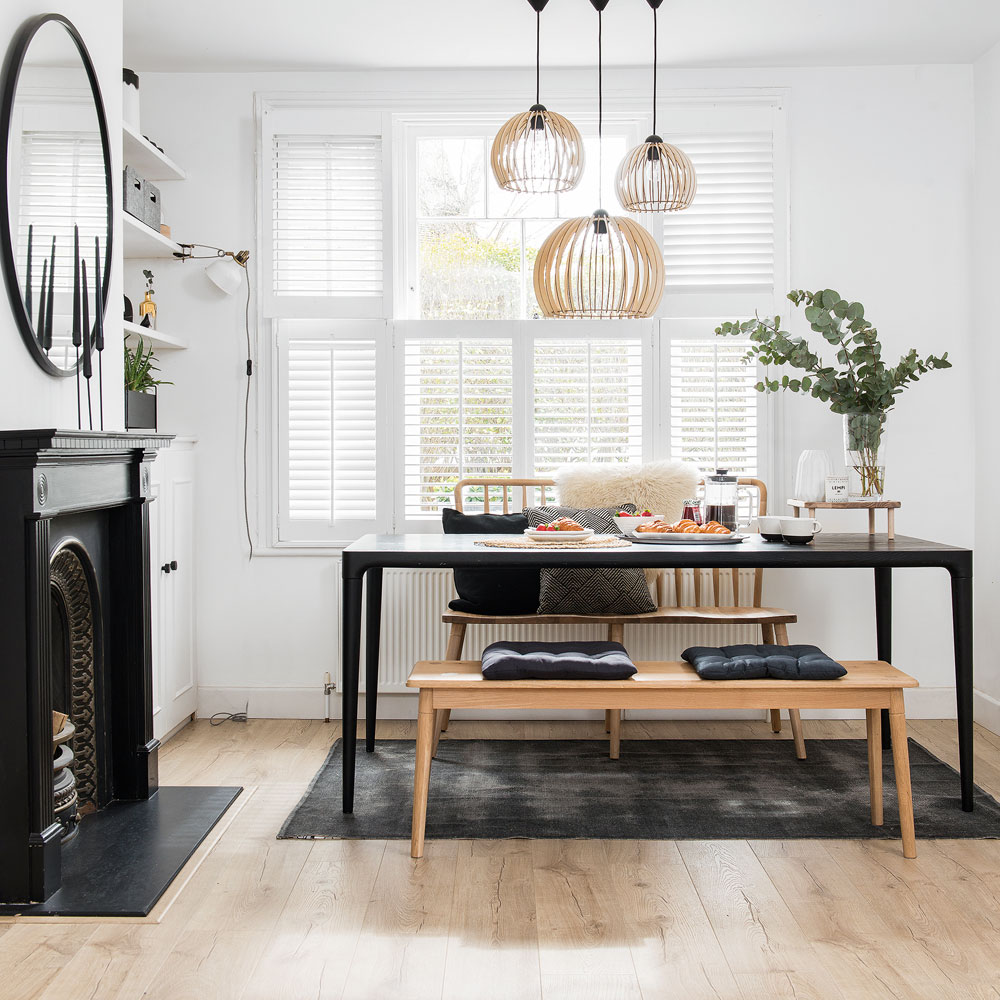
Break with the norm and add a decorative twist to the design rule of three (using the uneven number for displays, to avoid stark symmetry).
Use three lights, use the same lights even, but add interest by choosing to stagger the display, with different heights and sizes. You can of course buy lights that welcome the look, but this idea allows you to be flexible with exactly where you place each one.
30. Captivate with a cascading cluster design

To create a real talking point choose statement overhead dining room lighting ideas sure to start a conversation, such as a striking cascading design.
Not only does a cluster provide a style statement for the overall aesthetic it will also add light on many different levels to create a central focus of interest.
Be sure to position a show-stopper light in the middle of your your dining scheme to avoid it throwing the rest of the room off balance.
31. Make it personal

Add a touch of personality to your dining room with the addition of a bespoke light-up sign. From neon signs to retro diner designs choose a light to personalise your space. Not only is it a creative dining room wall decor idea, it also helps to add a touch of illumination too.
32. Mix and match pattern

A sociable dining area is a great place to have fun with pattern – and may encourage the family to sit at the table for dinner. Pick a colour, then clash patterns – as long as they're the same tone, you're guaranteed success. However, you may want to stick with a theme for your fabrics – like floral.
Buy a drum lampshade-making kit and you can make your own in a material you love. It's a surprisingly easy budget dining room idea!
33. Display fairy lights within foliage
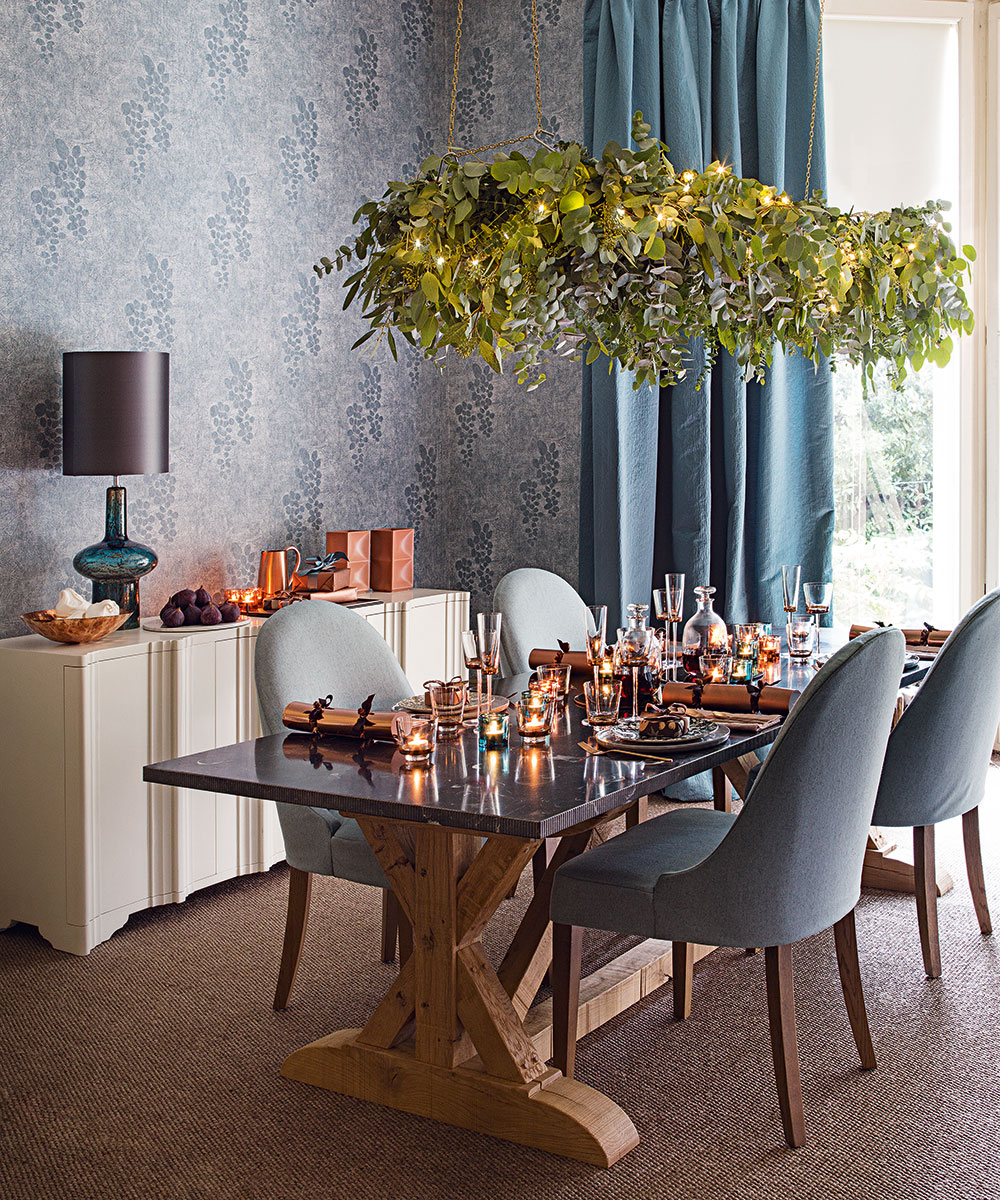
It's an amazing idea at Christmas, of course, but this look can be effective all year round. You will first need to assess how much weight your ceiling can hold.
If you're using a branch as a base, which is a good idea, make sure it's supported with several lengths of wire or metal chain, spread evenly for stable support.
Alternatively, you could attach foliage to existing fixtures, like ceiling rafters or a chandelier.
FAQs
Do you need a light over the dining table?
It is recommended to have some form of light above the dining table. Even though you can switch it off and swap it for other sources of light as the day and night progress.
‘It is always best to have some form of light over your dining room table as it will help everyone sitting around the table be able to see their food and drink and also illuminate tablescaping displays. People naturally gravitate towards pools of light so an over table light helps to create an intimate ambience that encourages conversation too,’ Ally at Dowsing & Reynolds recommends.
What lighting is best for a dining room?
Always base your lighting around your dining table. If the table is small just use a single pendant, if the table is large, use multiple lights or a bar pendant to an even light along the length of the table. Use a dimmer that can be turned up during the day and down at night for a more flattering light. We would always suggest combing a range of different lighting that can be blended depending on the task and mood using dimmers.
‘We love to use a focal lamp or pendant above the dining table that creates intimacy and is not too bright or harsh,' says Thomas Housden, design director of Hand and Eye Studio.
‘We then add one or two wall lights in key locations that can accent key walls and areas. We would then always suggest a couple of different free-standing lights so a small bookshelf light or a floor (uplight) light. These can add the homely feel and allow you to illuminate corners of rooms of a particular area of joinery etc.’
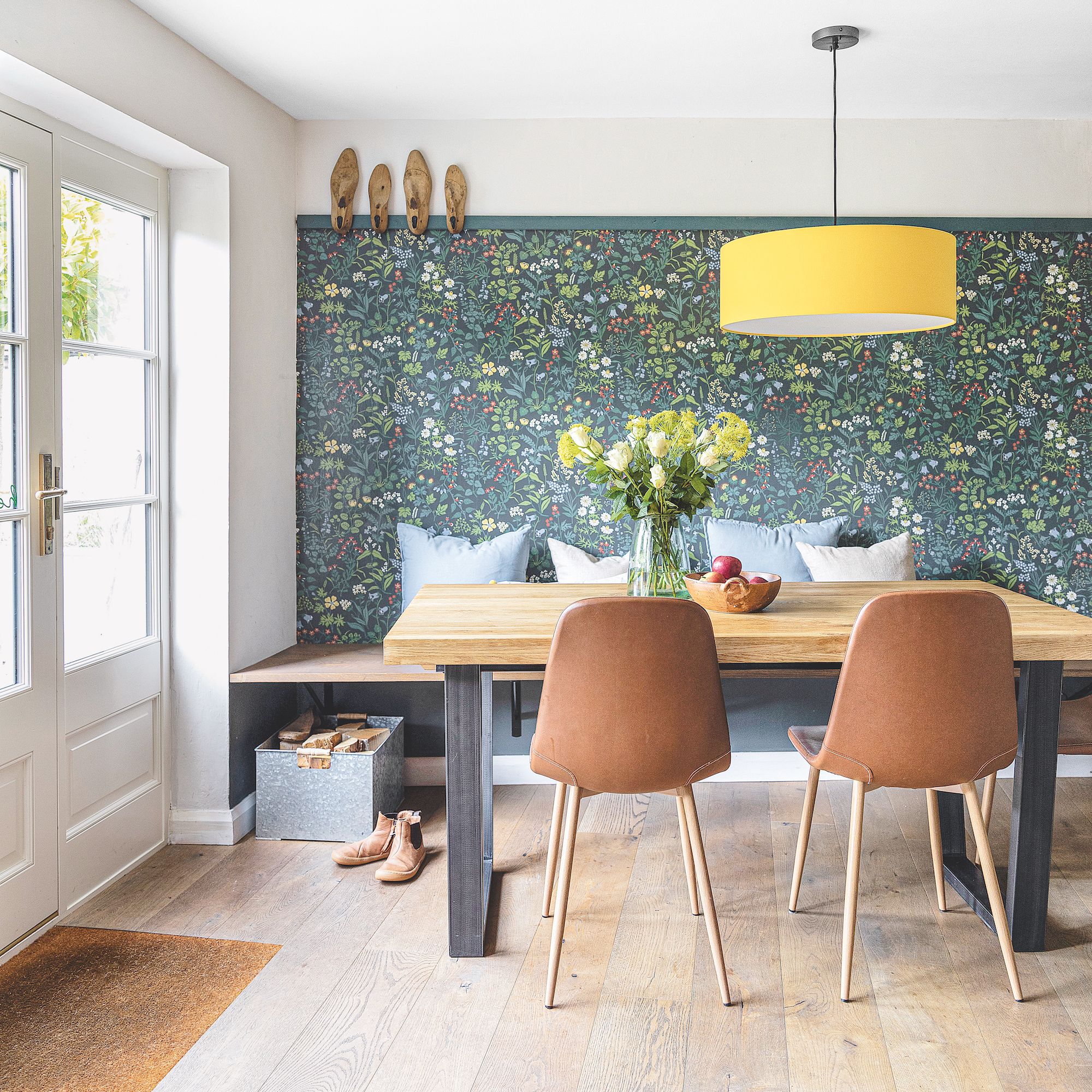
How low should a light be over a dining table?
'Low level lighting is best when it comes to the dining area,' says Victoria from Rothschild & Bickers. 'It creates intimacy but you don’t want to get stuck with a light that hangs too low or too high or an undersized or oversized light that will create disproportion in your interior.'
'The general rule to follow for dining room lighting ideas is to ensure the bottom of the light fixture is between 30 and 36 inches from the top of your table,' adds Mara from Industville.
'The standard recommendation is based on an average sized room however, factors such as the ceiling height, room size, table size and the amount of light that is projected from by the fixture should also be taken into account.'
These tips will ensure that there is no harsh overhead lighting in your dining room but equally, you won’t have to look for your food in the dark. In short, your ambient lighting will be both stylish and functional.







